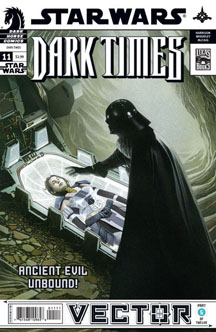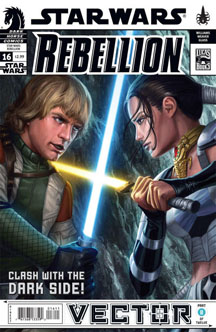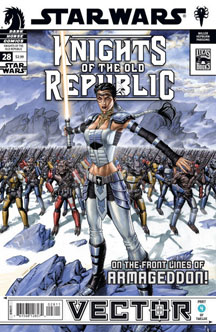Dark Horse editor Randy Stradley begins his introduction to the first trade-paperback volume of “Vector” (2008) by apologizing for the “crass commercialism” of the crossover project. But he needn’t have apologized. The idea of a story that travels through the four ongoing “Star Wars” comics of the time may have been commercial, but it was also just plain cool.
Even if the finished project didn’t elevate any of the four titles (which shows how strong they were without gimmicks), I appreciate “Vector” for its narrative ambition, especially since the only other major crossover in “Star Wars” lore came way back in the “Ewoks” and “Droids” comics of the 1980s. (There are also several bits of synergy that weren’t heavily advertised as crossovers, such as the way “The Lost Tribe of the Sith” links to “Fate of the Jedi.”)
Here’s a breakdown of the 12-issue “Vector” story:
Part 1: “Knights of the Old Republic” Issues 25-28
Part 2: “Dark Times” Issues 11-12
Part 3: “Rebellion” Issues 15-16
Part 4: “Legacy” Issues 28-31
The linking elements are the Old Republic Jedi Celeste Morne and her Muur Talisman, which contains the spirit of Dark Lord Karness Muur, a Sith so ancient he predates the Sith Order. The trinket allows the user to turn humans (but conveniently for storytelling purposes, not Force users or aliens) into rakghouls, which are essentially monster zombies. Although Morne uses the beasts to protect herself, she doesn’t crave power; she simply doesn’t want the talisman to fall into the wrong hands. Eventually, the scenes of lightsabers slicing through armies of slavering rakghouls get old, as do Muur’s constant whispers into Morne’s ear to let him take over her body so she can be at peace.
Morne is at her most likable in John Jackson Miller’s “Knights of the Old Republic.” A member of Master Lucien’s secret Covenant, she refuses Lucien’s order to kill Zayne, as she believes it is the wrong thing to do – despite being annoyed by Zayne and Gryph’s constant chatter. By “Legacy,” Morne is the one who is constantly bickering (with Muur’s spirit).
Having been left in a life-sustaining oubliette for 4,000 years between “Knights” and “Dark Times,” and then left stranded on a moon by Darth Vader for 20 years between “Dark Times” and “Rebellion,” Morne earns a reader’s sympathy. However, because she’s consistently noble and unselfish, she’s kind of boring in the first three parts. By the time of “Legacy” – after floating on an empty ship for 135 years, kept young-looking as a side effect of the talisman — she starts to become disaffected and less likable.
Contrasting with the ancient feel of “Tales of the Jedi,” “Knights” had always been oddly colorful with the bumbling Zayne and opportunistic Gryph, and Scott Hepburn’s cartoonish art – reminiscent of Carlos Meglia’s in “Underworld: The Yavin Vassilika” – finally matches the tone here.

That makes for a rather jarring switch to the painted panels of Douglas Wheatley and Dave Ross on Stradley’s “Dark Times,” although it fits with the grim story of Vader ambushing the Uhumele crew on a remote moon and trying to make Morne into his apprentice. Always a title that lives up to its moniker, “Dark Times” dispatches its one human crew member, Crys, in this arc. (Dass Jennir is off brooding somewhere during “Vector.”)


The “Rebellion” issues, penned by Rob Williams with nice art by Dustin Weaver, consist of Luke, Leia, Han, Chewie, Deena and Able fighting off rakghouls on the moon where Vader stranded Morne. Williams gives us a nice bit of continuity when Vader mulls whether or not to go after his son. Vader reflects on “what he learned on Centares – and then later from Sunber”: his son’s existence and name. Janek Sunber is a reference to earlier “Rebellion” comics and the planet Centares is a reference to the Marvel comics and “Vader’s Quest.”
Unlike the other three titles, which continued for several more years, “Rebellion” ended its run with “Vector.” Able meets his end on the battlefield, but Deena’s arc gets stranded. The main heroes would next be seen chronologically in Brian Wood’s “Star Wars,” but Wood did nothing to acknowledge the “Rebellion” threads, let alone continue them.

Aside from the almost Kevin J. Anderson-esque taunting between Morne and Muur, the “Legacy” issues mark the best part of “Vector.” This is partly because John Ostrander’s series is the best-written of the four titles (another positive: Jan Duursema draws these issues) and partly because Morne joins in on Cade and company’s journey to kill Darth Krayt – a plot introduced at the end of the previous “Legacy” arc. So while “Vector” somewhat represented side trips for the heroes of “Knights,” “Dark Times” and “Rebellion,” the “Legacy” saga incorporates Morne rather than getting sidetracked to accommodate her story.
Despite featuring all the factions except the Galactic Alliance Remnant, the big Sith versus good-Force-users showdown finds room for nice character moments – notably Cade and Imperial Knight Azlyn Rae reigniting the flame from their days as Padawans (something that will no doubt miff Deliah Blue in future stories, as did Cade’s liaison with Darth Talon awhile back). And I love the fact that the action takes place on the mythic Core world Had Abbadon, which as “Star Wars” die-hards know was the name of the Imperial capital planet in early drafts of “Return of the Jedi.”
All told, “Vector” was a nice experiment; I’m glad Dark Horse tried a major crossover once during its time with the “Star Wars” license. That having been said, I’ll be happy to step back from the epic scope, rakghoul slaughters and whispering Sith spirits when I resume my re-reads of “Knights,” “Dark Times” and “Legacy.”

